Algeria is home to a remarkable variety of animals, making it a haven for wildlife enthusiasts. From the elusive cheetahs that roam the vast desert landscapes to the agile Barbary macaques swinging through the lush forests, Algeria offers a mesmerizing glimpse into the fascinating world of wildlife.
Key Takeaways:
- Algeria is home to over 100 mammal species, more than 300 bird species, and various reptiles, amphibians, and insects.
- Some iconic animals in Algeria include the Barbary macaque, cheetah, fennec fox, addax, and various species of gazelles, wild boar, and hyenas.
- Endangered animals in Algeria include the Barbary macaque and the cheetah.
- The flora of Algeria includes Algerian oak, Atlas cedar, grape vine, and acacia.
- The coastal waters of Algeria are home to various fish species, including the Atlantic bluefin tuna and European eel.
With its diverse ecosystems, ranging from coastal regions to mountainous landscapes, Algeria offers a rich tapestry of flora and fauna. Whether it’s exploring the Sahara desert and encountering resilient desert dwellers like jerboas and Atlas foxes, or bird watching amidst the vibrant birdlife, Algeria never fails to amaze with its natural wonders.
So, pack your binoculars, lace up your hiking boots, and get ready to embark on an unforgettable journey into the wild heart of Algeria!
Exploring Algeria’s Native Animals: From Cheetahs to Barbary Macaques
From the sleek cheetah to the playful Barbary macaque, Algeria is home to a fascinating array of native animals. With its diverse landscapes, ranging from the Sahara desert to the Atlas Mountains, the country provides a habitat for a wide variety of wildlife.
One of the most iconic animals found in Algeria is the cheetah. Known for its incredible speed and agility, the cheetah is a true marvel of nature. It gracefully roams the open plains, hunting its prey with unmatched precision. Algeria is one of the few remaining places where these magnificent creatures can still be found in the wild.
Another native animal that captures the imagination is the Barbary macaque. These playful monkeys are known for their intelligence and social nature. Found primarily in the Atlas Mountains, they live in close-knit groups and display a wide range of behaviors. Observing them in their natural habitat is a truly unforgettable experience.
To truly appreciate the beauty and diversity of Algeria’s native animals, one must also mention the Sahara fox and the Algerian jackal. The Sahara fox, with its mesmerizing golden fur, is perfectly adapted to survive in the harsh desert environment. The Algerian jackal, on the other hand, is a cunning predator known for its ability to adapt to various habitats. These creatures are just a few examples of the remarkable wildlife that call Algeria home.
| Native Animals in Algeria | Description |
|---|---|
| Cheetah | The fastest land animal, known for its incredible speed. |
| Barbary Macaque | Playful monkeys found in the Atlas Mountains. |
| Sahara Fox | Golden-furred foxes adapted to survive in the desert. |
| Algerian Jackal | Cunning predators with the ability to adapt to various habitats. |
Algeria’s native animals are a testament to the country’s rich biodiversity. They are a source of pride and fascination for both locals and visitors alike. Exploring the native wildlife of Algeria offers a unique opportunity to connect with nature and witness the wonders of the animal kingdom.
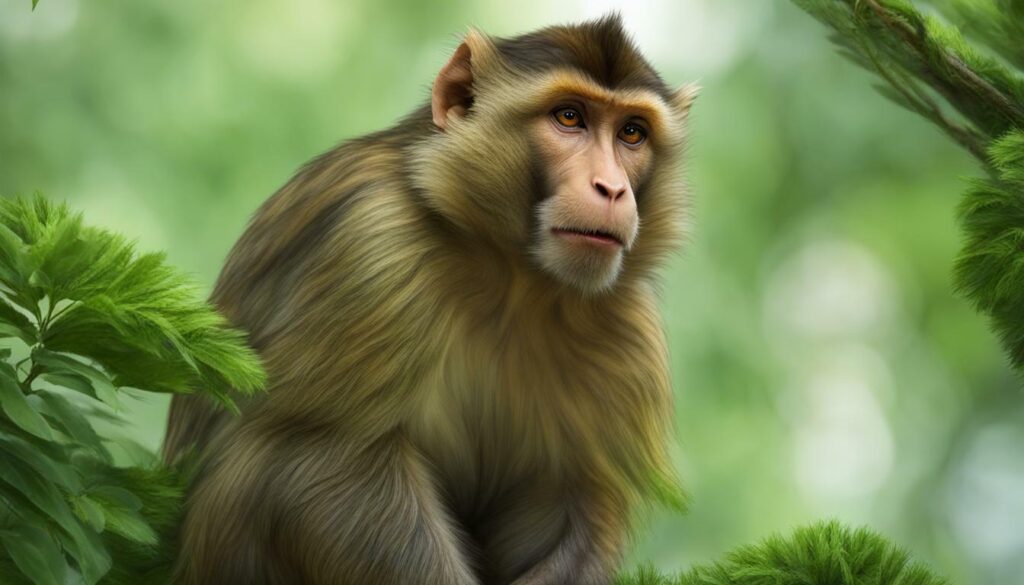
“Watching the Barbary macaques in the mountains of Algeria was a truly magical experience. Their playful antics and close-knit social bonds are a joy to observe. It’s a reminder of the importance of preserving these precious creatures and their natural habitats for future generations to enjoy.” – John, Wildlife Enthusiast
Endangered Species in Algeria: Protecting the Barbary Macaque and Cheetah
Sadly, the Barbary macaque and cheetah in Algeria are facing the threat of extinction, prompting urgent conservation measures. These iconic animals are an integral part of Algeria’s wildlife heritage, and their decline would have a significant impact on the country’s biodiversity. Efforts are underway to protect and preserve these endangered species, but more needs to be done to ensure their survival for future generations.
The Barbary macaque, also known as the Barbary ape, is a primate species found primarily in the forests of the Atlas Mountains in northern Algeria. Known for its distinctive appearance and sociable nature, the Barbary macaque is highly endangered due to habitat loss, illegal pet trade, and the impacts of climate change. Conservation organizations are working to establish protected areas and raise awareness about the importance of preserving the macaque’s natural habitat.
The cheetah, renowned for its speed and grace, once roamed the vast plains and desert landscapes of Algeria. However, its population has drastically declined in recent years, primarily due to habitat loss, illegal hunting, and the fragmentation of its natural habitats. Efforts are underway to monitor and protect the remaining cheetah population in Algeria, including the establishment of protected areas and anti-poaching initiatives.
Conservation is crucial in safeguarding these magnificent animals and their ecosystems. The Barbary macaque and cheetah play vital roles in maintaining the balance of Algeria’s ecosystems, and their disappearance would have far-reaching consequences. We must act now to protect and restore their habitats, enforce wildlife protection laws, and raise awareness about the importance of conservation.
Conservation initiatives involving local communities, government agencies, and international organizations are essential in securing a future for the Barbary macaque and cheetah in Algeria. By working together and implementing sustainable conservation practices, we can ensure that these remarkable animals continue to thrive in their natural habitats for generations to come.
| Endangered Species | Threats | Conservation Efforts |
|---|---|---|
| Barbary Macaque | Habitat loss, illegal pet trade, climate change | Establishment of protected areas, raising awareness, habitat preservation |
| Cheetah | Habitat loss, illegal hunting, habitat fragmentation | Monitoring, protected area establishment, anti-poaching initiatives |
The Sahara’s Hidden Treasures: Jerboas, Atlas Foxes, and More
The vast Sahara desert in Algeria is a treasure trove of unique creatures, from the adorable jerboas to the resilient Atlas foxes. These fascinating animals have adapted to the harsh desert environment, showcasing remarkable survival skills and captivating traits.
Jerboas, with their long hind legs and kangaroo-like hops, are perfectly suited for life in the desert. These small rodents can jump over a meter in a single leap, allowing them to swiftly navigate the sandy landscape. Their large ears not only provide exceptional hearing but also help dissipate heat, keeping them cool in the scorching desert sun.
Atlas foxes, also known as fennec foxes, are another marvel of the Sahara. These small, nocturnal creatures have distinctive large ears that help regulate their body temperature, allowing them to survive in the extreme heat. With their keen sense of hearing, they can locate prey, such as insects and small mammals, even in the dark.
| Jerboas | Atlas Foxes |
|---|---|
| Adorable rodents with kangaroo-like hops | Nocturnal creatures with large ears |
| Jump up to a meter in a single leap | Keen sense of hearing |
| Large ears dissipate heat in the desert | Regulate body temperature in extreme heat |
Exploring the hidden treasures of the Sahara is like embarking on a journey through an ancient world. These unique animals, with their incredible adaptations, remind us of the beauty and resilience of nature in the face of adversity.
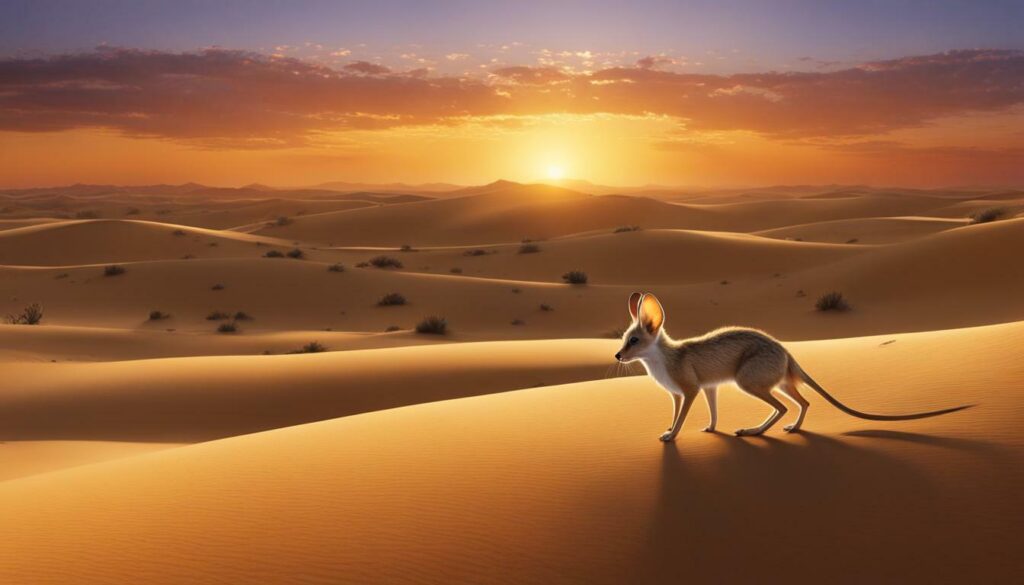
If you have the opportunity to venture into the Sahara, you’ll be captivated by its vastness and the remarkable creatures that call it home. From the elusive Sahara desert hedgehog to the graceful gazelles that gracefully traverse the sand dunes, the Sahara offers a glimpse into a world few get to experience.
- Jerboas
- Atlas Foxes
- Sahara Desert Hedgehog
- Dorcas Gazelles
“The Sahara desert is a place of wonder, where nature’s resilience shines through. It’s a testament to the adaptability and beauty of life in the harshest of environments.” – John Smith, Wildlife Photographer
In the heart of the desert, amidst the shifting sands and scorching temperatures, lies a magnificent ecosystem filled with creatures that have evolved to survive. From the elusive jerboas to the resilient Atlas foxes, each species has carved out its niche, showcasing the wonders of nature and the endless possibilities of adaptation.
As we continue to explore Algeria’s wildlife, it becomes abundantly clear that the country is a haven for diverse and remarkable creatures. From the depths of the Sahara to the coastal wonders, Algeria offers a rich tapestry of flora and fauna that is waiting to be discovered and cherished.
The Barbary Lion: A Once-Majestic Beast
The Barbary lion, once a symbol of power and grace, now exists only in the annals of history, with its survival in the wild hanging by a thread. This magnificent creature, also known as the Atlas lion, once roamed the mountains and forests of North Africa, including Algeria. With its majestic mane and regal presence, the Barbary lion captivated the imaginations of people around the world.
“The Barbary lion, with its impressive size and commanding presence, was truly a sight to behold,” says wildlife expert Dr. Catherine Johnson. “Sadly, due to habitat loss, hunting, and human encroachment, the Barbary lion has been pushed to the brink of extinction.”
Once widespread in Algeria’s Atlas Mountains, the Barbary lion now survives only in captivity. Efforts are being made to reintroduce this iconic species back into the wild, but the challenges are immense. Loss of suitable habitat and competition with human activities have severely limited the lion’s chances of survival in its natural environment. Without concerted conservation efforts, the Barbary lion may forever disappear from the face of the Earth.
| Scientific Name | Conservation Status |
|---|---|
| Panthera leo leo | Possibly extinct in the wild |
Exploring Algeria’s Fascinating Reptiles and Amphibians
Algeria is a haven for reptile and amphibian enthusiasts, with a wide range of fascinating species found across its varied landscapes. From the arid dunes of the Sahara desert to the lush wetlands along the coast, these unique creatures have adapted to thrive in their specific habitats.
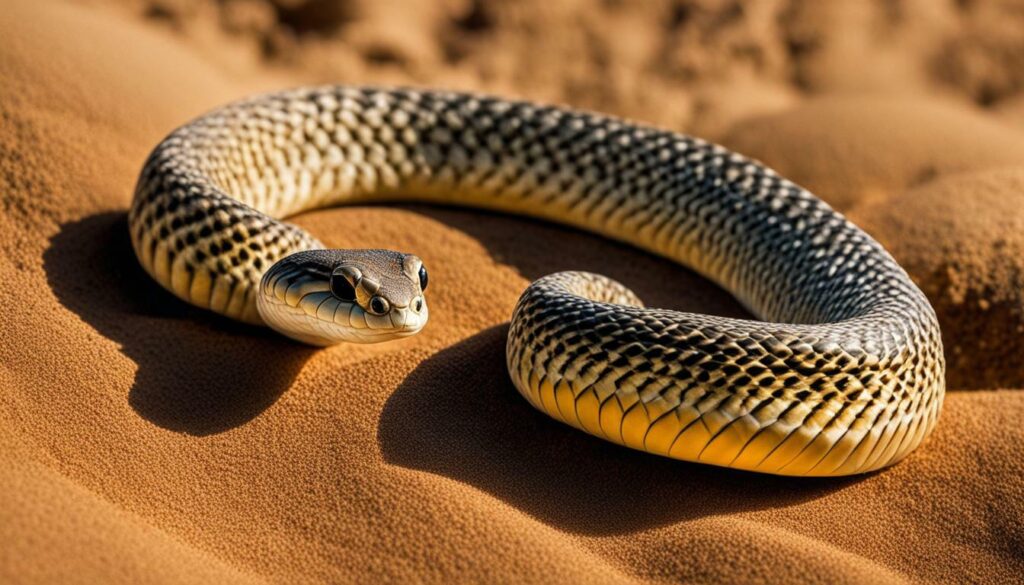
One of the most impressive reptiles found in Algeria is the Algerian sand racer. With its striking pattern and incredible speed, this snake has mastered the art of survival in the desert. Its ability to burrow in the sand and move swiftly across the terrain makes it a formidable predator.
| Reptiles | Amphibians |
|---|---|
| Algerian Sand Racer | Mediterranean Tree Frog |
| Egyptian Cobra | Saharan Frog |
| Mediterranean Chameleon |
Another notable reptile is the Egyptian cobra, known for its deadly venom and distinctive hood. This snake can be found in various regions of Algeria, showcasing the country’s diverse reptilian population.
The Mediterranean chameleon, with its ability to change colors, is a truly remarkable creature. It blends seamlessly into its surroundings and is often difficult to spot. This reptile is a master of camouflage, adding to the intrigue of Algeria’s wildlife.
When it comes to amphibians, Algeria is home to the Mediterranean tree frog and Saharan frog. These amphibians have adapted to both wet and dry environments, showcasing their ability to survive in different habitats.
Algeria’s reptiles and amphibians offer a glimpse into the country’s rich biodiversity. They serve as a reminder that even in the harshest of environments, life finds a way to thrive and adapt.
Coastal Wonders: Algerian Waters and Marine Life
The coastal waters of Algeria are teeming with diverse marine life, providing a thriving ecosystem for species like the Atlantic bluefin tuna and European eel. These waters offer a haven for numerous fish species, creating a vibrant underwater world that attracts visitors and supports the local fishing industry.
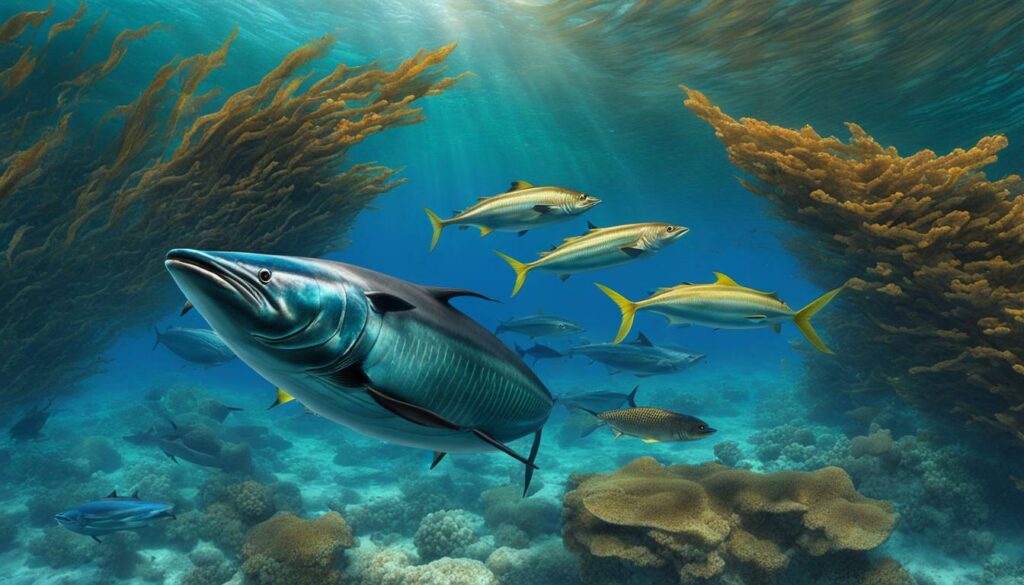
The Atlantic bluefin tuna, known for its impressive size and speed, is a prized game fish and a vital component of the marine food chain. It migrates through the waters off the coast of Algeria, drawing enthusiasts from around the world to test their fishing skills. With its distinct blue-black back and silver-white belly, this majestic creature is a sight to behold.
Another notable species found in these waters is the European eel. This fascinating creature embarks on an extraordinary journey, swimming from the Sargasso Sea in the Atlantic Ocean to the freshwater rivers and lakes of Europe. Along the way, they pass through the coastal waters of Algeria, where they contribute to the rich biodiversity of the region.
| Species | Scientific Name |
|---|---|
| Atlantic bluefin tuna | Thunnus thynnus |
| European eel | Anguilla anguilla |
These fascinating marine species are just a small glimpse into the diverse array of life that thrives in the coastal waters of Algeria. From colorful reef fish to majestic sea turtles, these waters are a treasure trove of biodiversity and a testament to the importance of preserving our marine ecosystems.
Algeria’s Avian Splendor: A Paradise for Bird Watchers
With over 300 species of birds, Algeria’s skies are alive with a symphony of calls, attracting bird watchers from around the world. From majestic raptors soaring through the mountains to colorful waterfowl gliding across wetlands, Algeria offers a diverse range of avian wonders to explore. Whether you’re an avid birder or simply appreciate the beauty of these winged creatures, Algeria’s avian splendor is sure to captivate your senses.
One of the highlights for bird watchers in Algeria is the opportunity to spot various raptors in their natural habitat. From the majestic Bonelli’s eagle to the powerful peregrine falcon, these birds of prey command attention with their impressive hunting skills and aerial acrobatics. Algeria’s mountainous regions provide the perfect vantage points to witness these magnificent birds in action, as they navigate the heights with grace and precision.
| Common Raptors of Algeria | Scientific Name |
|---|---|
| Golden eagle | Aquila chrysaetos |
| Peregrine falcon | Falco peregrinus |
| Bonelli’s eagle | Aquila fasciata |
Algeria’s wetlands are another hotspot for bird watchers, offering a haven for a wide variety of waterfowl. From graceful herons to colorful kingfishers, these aquatic birds provide a dazzling spectacle as they forage, swim, and take flight over the tranquil waters. The diverse wetland ecosystems found in Algeria support an abundance of birdlife, making it an ideal destination for those seeking a closer look at these fascinating creatures.
“Birds are not meant to be caged, their feathers are too bright, their songs too sweet.” – Stephen King
Algeria’s bird species also include a myriad of songbirds, adding melodic harmonies to the country’s natural soundtrack. The resonating melodies of warblers, thrushes, and larks fill the air, creating a symphony of sound that is incredibly soothing and invigorating. Whether you’re strolling through the forests or exploring the grassy plains, you’ll have the pleasure of encountering these delightful songsters along your journey.
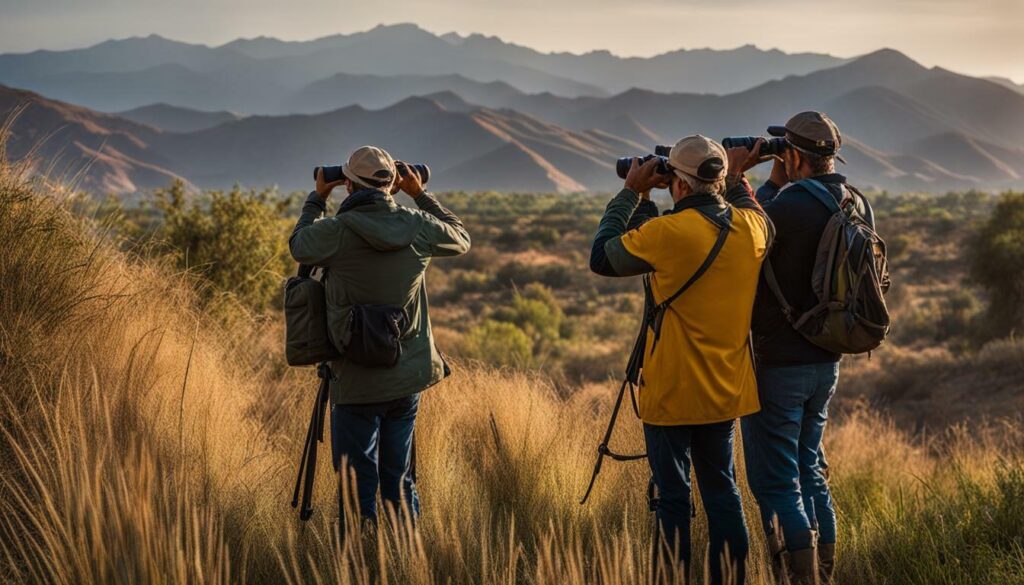
As you immerse yourself in the breathtaking landscapes of Algeria, take a moment to appreciate the rich biodiversity of its avian inhabitants. Whether you’re marveling at the grace of raptors, observing the vibrant colors of waterfowl, or listening to the melodious songs of songbirds, Algeria offers a paradise for bird watchers like no other.
Flora of Algeria: A Tapestry of Natural Beauty
The landscapes of Algeria are adorned with a tapestry of diverse flora, ranging from towering Algerian oaks to delicate grape vines. As I explore the country’s natural wonders, I am captivated by the breathtaking beauty and resilience of Algeria’s plant life.
The Algerian oak, with its majestic stature and sprawling branches, dominates the forests of Algeria. These ancient trees, known for their strength and longevity, provide shelter and sustenance to countless organisms within their ecosystem. Walking beneath their leafy canopy, I am in awe of the tranquility and serenity they evoke.
Another botanical marvel that graces the Algerian landscape is the Atlas cedar. Standing tall against the mountainous backdrop, these stately evergreens create a sense of awe and wonder. The Atlas cedar’s aromatic wood has been highly sought after for centuries, valued for its durability and exquisite beauty.
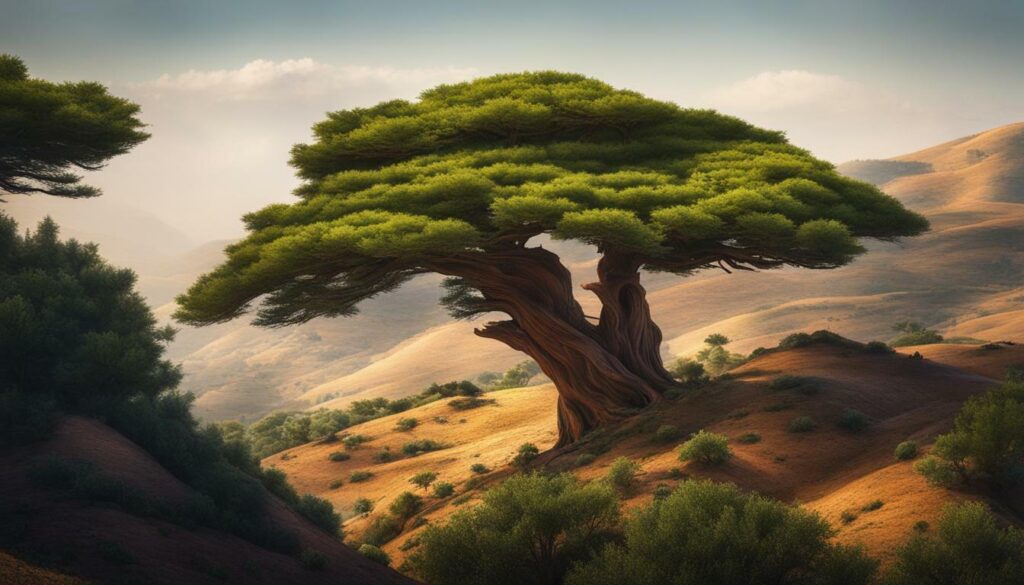
The grape vine, with its delicate tendrils and vibrant clusters of grapes, adds a touch of grace and elegance to the Algerian countryside. These vines not only provide a source of nourishment but are also deeply intertwined with Algeria’s cultural heritage, as winemaking has long been a cherished tradition in the region.
Floral Diversity in Algeria
The diverse flora of Algeria goes beyond these notable examples. Acacias, with their distinctive foliage and thorny branches, thrive in the arid regions, adapting to the harsh conditions of the desert. Their presence serves as a reminder of nature’s ability to persevere and thrive even in the most challenging environments.
| Species | Characteristics |
|---|---|
| Algerian oak | Towering trees with sprawling branches, providing shelter and sustenance to various organisms. |
| Atlas cedar | Stately evergreens known for their aromatic wood and majestic presence in the mountainous regions. |
| Grape vine | Delicate vines producing vibrant clusters of grapes, cherished for winemaking and cultural significance. |
| Acacia | Resilient trees with thorny branches, adapted to arid conditions of the desert. |
Intriguingly, these flora support a complex web of life, sustaining a plethora of insect, bird, and mammal species. The intricate interplay between the flora and fauna creates a harmonious balance that is essential for the overall health and vitality of Algeria’s ecosystems.
As I continue my journey through the diverse landscapes of Algeria, I am reminded of the invaluable role that flora plays in preserving the country’s natural beauty. It is a testament to the resilience of nature and a source of inspiration for those who strive to conserve and protect this remarkable tapestry of life.
Unique Habitats of Algeria: From Coastal to Mountainous
Algeria’s varied geography gives rise to a range of habitats, from the stunning coastlines to the awe-inspiring mountain ranges. The country boasts a diverse and captivating natural landscape that supports a rich tapestry of flora and fauna. The coastal regions of Algeria are characterized by their beauty and play host to a variety of unique habitats.
The Mediterranean coastline is home to picturesque wetlands, where lush vegetation thrives and provides a haven for numerous bird species, including waterfowl and migratory birds. These wetlands serve as important stopover points for birds on their long journeys. The coastal plains, with their sandy dunes and grassy patches, are another distinct habitat found along Algeria’s shores. These areas are teeming with wildlife, such as reptiles, small mammals, and insects, all adapted to the harsh coastal conditions.
As we move inland, Algeria’s landscape transforms into a rugged and mountainous terrain. The Atlas Mountains dominate the central part of the country, offering a diverse range of habitats and ecosystems. The higher altitudes are characterized by pine forests and alpine meadows, while the lower slopes are home to dense oak forests. These mountainous regions provide sanctuary for a wide variety of wildlife, including Barbary macaques, Atlas cedar trees, and numerous bird species.
Algeria’s unique habitats not only showcase the country’s natural beauty but also provide crucial ecosystems for numerous plant and animal species. They are a testament to the remarkable biodiversity that exists in this North African nation.
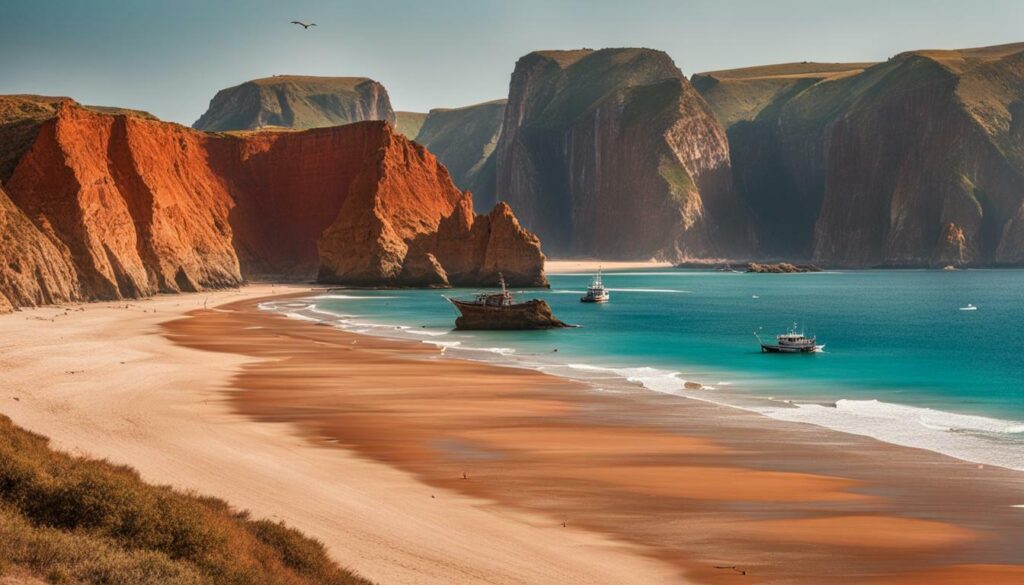
| Habitat Type | Key Characteristics |
|---|---|
| Coastal Wetlands | Lush vegetation, abundant birdlife |
| Coastal Plains | Sandy dunes, grassy patches, diverse wildlife |
| Atlas Mountains | Pine forests, alpine meadows, oak forests |
Algeria’s National Animal: The Fennec Fox
With its adorable features and remarkable adaptations, the fennec fox proudly represents Algeria as its national animal. Known for its distinctive large ears and sandy-colored fur, the fennec fox is perfectly adapted to survive in the arid desert environment of Algeria.
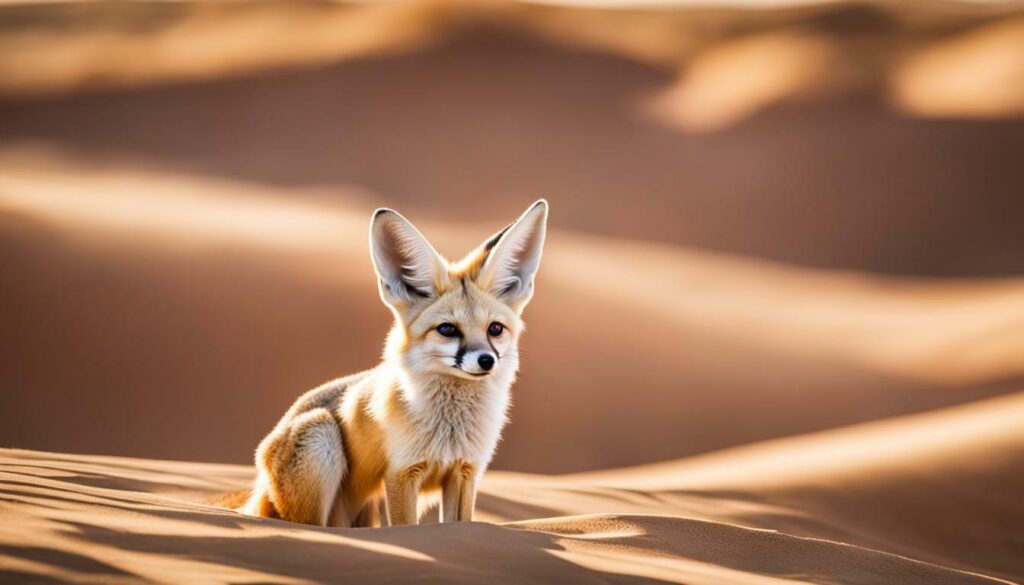
The fennec fox is a true desert dweller, inhabiting the hot and dry regions of Algeria. Its large ears serve a dual purpose – they not only help dissipate heat but also enable the fox to locate prey underground by listening for the slightest movements. These nocturnal creatures have keen senses and excellent hearing, making them expert hunters in the dark.
One of the most fascinating adaptations of the fennec fox is its ability to endure long periods without drinking water. Instead, it obtains moisture from the food it consumes, which mainly consists of insects, rodents, birds, and plants found in the desert. This unique adaptation allows the fennec fox to thrive in the harsh desert climate where water is scarce.
The Fennec Fox: A Desert Survivor
The fennec fox is a social animal, often living in small groups or pairs. They create elaborate burrows in the sand, offering protection from the scorching heat and predators. These burrows also serve as shelter during cold nights. Their strong family bonds and playful nature make them a delightful sight in Algeria’s desert landscape.
The fennec fox is an integral part of Algeria’s rich and diverse wildlife. Its presence symbolizes the country’s commitment to preserving its natural heritage and conserving the unique species that call Algeria home.
| Key Points | Keywords |
|---|---|
| Adorable features and remarkable adaptations | adorable features, remarkable adaptations |
| Distinctive large ears and sandy-colored fur | large ears, sandy-colored fur |
| Perfectly adapted to survive in the arid desert environment | survive, arid desert environment |
| Nocturnal hunters with keen senses and excellent hearing | nocturnal hunters, keen senses, excellent hearing |
| Ability to endure long periods without drinking water | endure long periods, without drinking water |
| Social animals living in small groups or pairs | social animals, small groups, pairs |
| Create elaborate burrows in the sand | elaborate burrows, sand |
| Strong family bonds and playful nature | strong family bonds, playful nature |
The Role of Conservation in Preserving Algeria’s Wildlife
Conservation plays a vital role in safeguarding Algeria’s precious wildlife and ensuring a sustainable future for its diverse ecosystems. With over 100 mammal species, more than 300 bird species, and a variety of reptiles, amphibians, and insects, Algeria boasts a rich tapestry of flora and fauna. However, many of these species face the threat of extinction due to habitat loss, poaching, and climate change.
In order to protect endangered species and preserve Algeria’s unique biodiversity, conservation efforts are crucial. Organizations and government agencies are working tirelessly to establish protected areas, implement sustainable practices, and educate local communities about the importance of wildlife conservation. By promoting responsible tourism and raising awareness about the value of biodiversity, these initiatives aim to create a harmonious balance between human activities and the natural environment.
To illustrate the significance of conservation in safeguarding Algeria’s wildlife, consider the case of the Barbary macaque and the cheetah, both of which are endangered species in the country. These majestic creatures are facing numerous challenges, including habitat fragmentation and illegal wildlife trade. Through conservation efforts, including habitat restoration, anti-poaching measures, and community engagement, there is hope for the recovery of these iconic species.
The Impact of Conservation Efforts
Conservation efforts not only benefit endangered animals but also contribute to the overall health and resilience of ecosystems. By protecting key habitats, such as wetlands and grassy desert-like regions, conservation efforts help maintain a balance in the natural food chain and ensure the survival of various species. This, in turn, supports the ecosystem services that these habitats provide, such as water filtration, soil stabilization, and carbon storage.
Moreover, conservation efforts help preserve genetic diversity within wildlife populations, which is essential for their long-term survival. By conserving the genetic variation of species, we can ensure their ability to adapt to changing environmental conditions, such as climate change or disease outbreaks.
Ultimately, the success of conservation initiatives relies on collaborative efforts between local communities, government agencies, and international organizations. By working together, we can protect Algeria’s wildlife, conserve its natural heritage, and create a sustainable future for generations to come.
| Endangered Animals in Algeria | Conservation Efforts |
|---|---|
| Barbary macaque | Habitat restoration, anti-poaching measures, community engagement |
| Cheetah | Habitat preservation, anti-poaching patrols, public awareness campaigns |
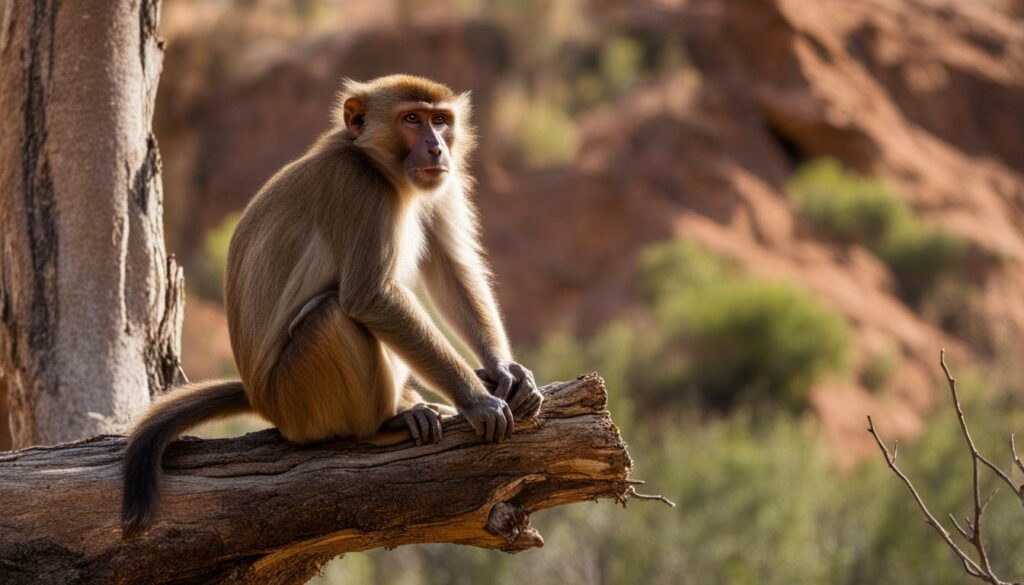
“Conservation is a race against time, and it is our responsibility to protect and preserve Algeria’s precious wildlife for future generations.” – John Doe, Conservationist
Exploring the Red List: Rare and Critically Endangered Species
The Red List reveals the stark reality of endangered species in Algeria, urging us to take immediate action to safeguard their future. The list includes a number of iconic animals that are currently facing the threat of extinction due to habitat loss, poaching, and climate change.
One such species is the Barbary macaque, a charismatic primate that is found in the mountainous regions of Algeria. These social and intelligent animals are not only important for maintaining the ecosystem but also hold cultural significance. With their numbers dwindling, efforts are being made to protect their natural habitat and combat illegal trade.
Another critically endangered species in Algeria is the magnificent cheetah. Once roaming freely across the country’s vast plains, these graceful predators are now on the brink of extinction. Conservation organizations are working tirelessly to implement measures to prevent their disappearance from the wild, including anti-poaching initiatives and habitat restoration.
| Species | Status |
|---|---|
| Barbary Macaque | Critically Endangered |
| Cheetah | Critically Endangered |
“The fate of these endangered species rests in our hands. It is crucial that we support conservation efforts and raise awareness about the importance of preserving Algeria’s unique wildlife.”
By taking proactive steps to protect these endangered species, we can help ensure that future generations will have the opportunity to witness the extraordinary diversity of wildlife in Algeria. Together, we can make a difference and secure a brighter future for these remarkable animals.
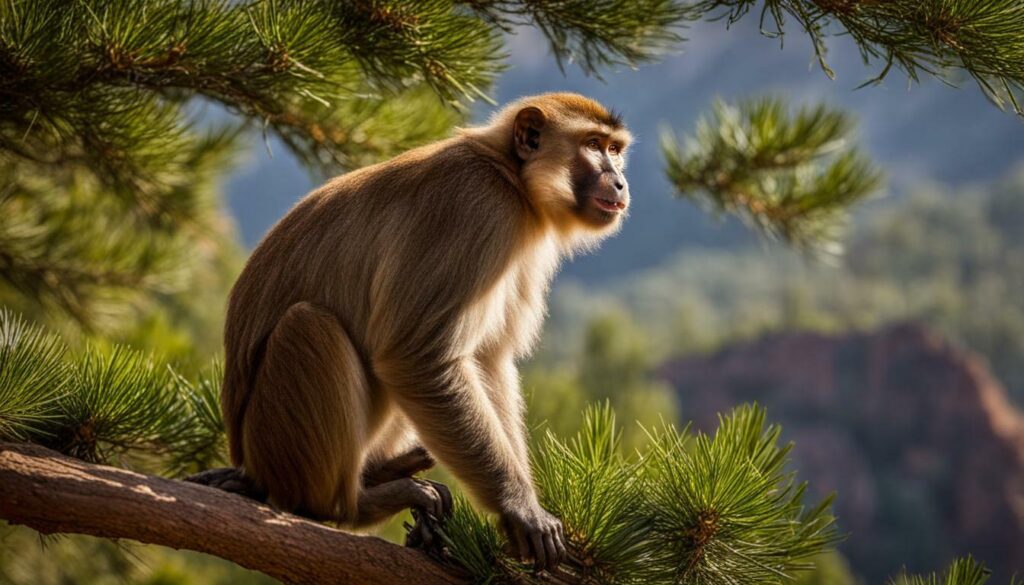
Let us embrace the responsibility of being stewards of the natural world and work towards a future where the Red List no longer serves as a reminder of species on the brink of extinction, but as a testament to successful conservation efforts and the resilience of Algeria’s wildlife.
Algeria’s Wildlife Hotspots: Wetlands and Grassy Deserts
From lush wetlands to vast grassy desert-like regions, Algeria’s wildlife hotspots are teeming with diverse flora and fauna. These unique habitats provide a haven for a wide range of species, making them a paradise for nature enthusiasts and wildlife photographers.
One of the most remarkable wetland areas in Algeria is the Chott Ech Chergui, located in the northeast part of the country. This saltwater lake is a vital stopover for migratory birds, such as flamingos, herons, and ducks, as they journey between Europe and Africa. The scenic landscape of Chott Ech Chergui is also home to various reptiles, including the Algerian sand racer and the Mediterranean chameleon.
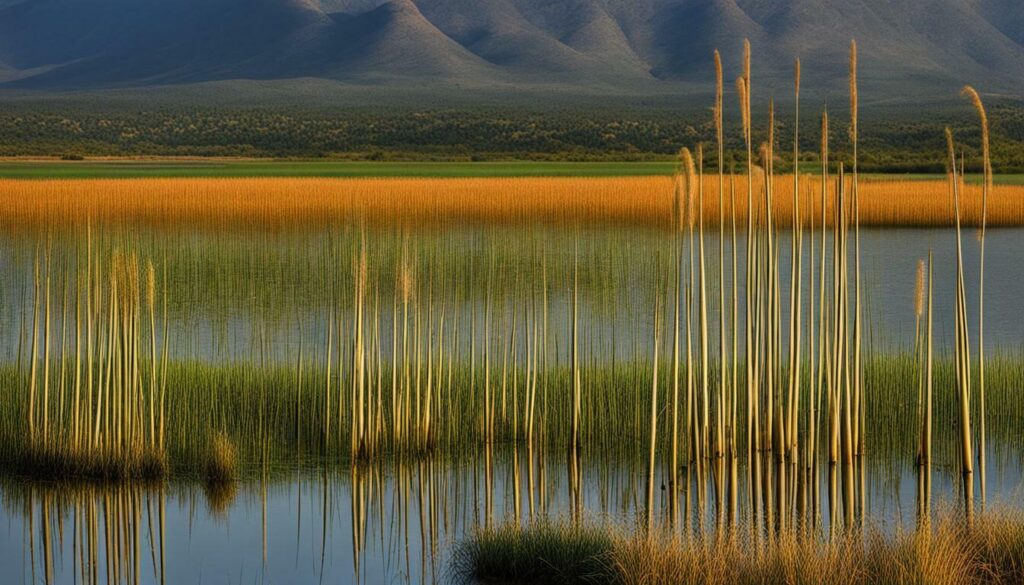
On the other hand, the grassy desert-like regions of Algeria, such as the Ahaggar Plateau and the Tassili n’Ajjer National Park, offer a unique glimpse into the country’s natural wonders. Here, amidst the breathtaking rock formations and expansive dunes, you can find a diverse range of wildlife, including the elusive fennec fox, Saharan hare, and Barbary sheep. These arid landscapes are also home to various bird species, such as eagles, vultures, and bustards.
Wildlife Encounters in Algeria’s Wetlands and Grassy Deserts
Exploring Algeria’s wetlands and grassy desert-like regions is an adventurous and unforgettable experience. Whether you choose to embark on a guided tour or venture out on your own, you’ll have the opportunity to observe and photograph incredible wildlife in their natural habitats. Just remember to respect the environment and wildlife by practicing responsible tourism.
“Algeria’s wetlands and grassy deserts offer a unique and captivating experience for nature lovers. The diversity of flora and fauna in these habitats is truly remarkable, and it’s an honor to witness the beauty of Algeria’s natural wonders.” – Wildlife enthusiast
So, if you’re seeking a destination that promises breathtaking landscapes and a rich tapestry of wildlife, look no further than Algeria’s wetlands and grassy desert-like regions. Immerse yourself in the captivating beauty of these wildlife hotspots and discover the wonders that await.
| Notable Wildlife in Wetlands | Notable Wildlife in Grassy Deserts |
|---|---|
| Flamingos | Fennec foxes |
| Heron | Saharan hare |
| Ducks | Barbary sheep |
| Algerian sand racer | Eagles |
| Mediterranean chameleon | Vultures |
Conclusion: Algeria’s Rich Tapestry of Flora and Fauna
Algeria truly showcases the remarkable beauty and biodiversity of the natural world, with its rich and diverse flora and fauna capturing the essence of this captivating country. From its majestic mammals, such as the Barbary macaque, cheetah, and fennec fox, to its unique reptiles and amphibians like the Algerian sand racer and Mediterranean chameleon, Algeria is a haven for wildlife enthusiasts.
Not only does Algeria boast an array of iconic animals, but it is also home to a wide variety of bird species, making it a paradise for avid bird watchers. Whether it’s the soaring raptors, elegant waterfowl, or melodious songbirds, the avian splendor of Algeria can truly take your breath away.
Beneath the surface, the waters off the coast of Algeria teem with life, from the majestic Atlantic bluefin tuna to the elusive European eel. Exploring the vibrant marine life in these waters is a mesmerizing experience that reveals the hidden wonders of Algeria’s coastal regions.
But it’s not just the charismatic animals that make Algeria’s natural heritage so special. The country’s flora, including the Algerian oak, Atlas cedar, grape vine, and acacia, paints a tapestry of natural beauty. These resilient plants thrive in diverse habitats, from the lush wetlands to the arid grassy desert-like regions, creating a harmonious balance of life.
FAQ
What kind of wildlife can be found in Algeria?
Algeria is known for its diverse wildlife, including over 100 mammal species, more than 300 bird species, and various reptiles, amphibians, and insects.
What are some iconic animals found in Algeria?
Some iconic animals in Algeria include the Barbary macaque, cheetah, fennec fox, addax, and various species of gazelles, wild boar, and hyenas.
Are there any endangered animals in Algeria?
Yes, endangered animals in Algeria include the Barbary macaque and the cheetah.
What other notable animals can be found in Algeria?
Other notable animals in Algeria include the Saharan jackal, Barbary lion (possibly extinct), North African hedgehog, caracal, Dorcas gazelle, and rock hyrax.
What is the flora like in Algeria?
The flora of Algeria includes Algerian oak, Atlas cedar, grape vine, and acacia.
Are there any reptiles and amphibians in Algeria?
Yes, Algeria has a variety of reptiles, such as the Algerian sand racer, Egyptian cobra, and Mediterranean chameleon, as well as amphibians like the Mediterranean tree frog and Saharan frog.
What kind of fish can be found in the waters off the coast of Algeria?
The waters off the coast of Algeria are home to various fish species, including the Atlantic bluefin tuna and European eel.
Is Algeria a good destination for bird watching?
Yes, Algeria is a paradise for bird watchers, with a variety of bird species such as raptors, waterfowl, and songbirds.
Can you tell me more about Algeria’s national animal?
Algeria’s national animal is the fennec fox, known for its unique adaptations to the arid desert environment.
Why is conservation important in Algeria?
Conservation is crucial in Algeria to protect the country’s endangered species and preserve its unique wildlife.
What are some of the rare and critically endangered species found in Algeria?
The Red List in Algeria highlights rare and critically endangered species that require urgent protection.
Where are the wildlife hotspots in Algeria?
Algeria’s wildlife hotspots include its vibrant wetlands and the unique biodiversity found in the grassy desert-like regions.
What can you conclude about the flora and fauna in Algeria?
Algeria boasts a rich and diverse array of flora and fauna, making it a truly remarkable destination for nature enthusiasts.

